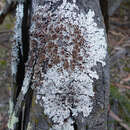Comprehensive Description
provided by Smithsonian Contributions to Botany
Pseudoparmelia texana
Pseudoparmelia texana (Tuckerman) Hale, 1974:191.
Parmelia texana Tuckerman, 1858:424 [type collection: Blanco, Texas, Wright (FH, lectotype; M, US, isolectotypes)].
Parmelia sublaevigata var. texana (Tuckerman) Nylander in Triana and Planchon, 1867:307.
Parmelia conftuescens Nylander, 1875:725 [type collection: St. Paul (H, Nylander herbarium number 35178, lectotype; BM, PC, UPS, isolectotypes)].
Parmelia cingalensis Stirton, 1876:159 [type collection: Galle, Ceylon (BM, lectotype); illegitimate name].
Parmelia leptophylla Müller Argoviensis, 1891:377 [type collection: Baziya, South Africa, Baer 714 (BM, lectotype; G, isolectotype)].
Parmelia tenuirima f. sorediata Müller Argoviensis, 1894:258 [type collection: Usambara (Tanganyika), Africa, Hoist 787 pro parte (G, lectotype)].
Parmelia exoriens Stirton, 1899:76 [type collection: Brisbane, Australia, Bailey 215 (BM, lectotype; GLAM, isolectotype)].
Parmelia symmiga Hue, 1899:168 [type collection: Coonoor, Nilgherries Mountains, India, Gray (PC, lectotype)].
Parmelia subconfluescens Magnusson, 1942:5 [type collection: Puu Waawaa, north of Hualalai, Hawaii, Selling 5669 (S, holotype)].
Parmelia mangenotii des Abbayes, 1951:969 [type collection: Mankono, Cercle of Séguéla, Ivory Coast, des Abbayes (REN, lectotype; US, isolectotype)].
Parmelia pseudorutidota Asahina, 1952:17 [type collection: Nagachi, Shinshu, Japan, Takahashi (TNS, lectotype)].
Parmelia tanakae Asahina, 1954:371 [type collection: Kuzu-Mura, Buzen, Prov. Yamato, Japan, Tanaka (TNS, lectotype)].
Parmelia albaniensis Dodge, 1959:121 [type collection: forests of Albany, Cape of Good Hope, Union of South Africa, Zeyher 3 (FH-Tayl, holotype)].
DESCRIPTION.—Thallus closely adnate on trees or rocks, ashy white, 6–12 cm broad; lobes sublinear to subirregular, apically rotund, 3–5 mm wide; upper surface plane to rugulose, usually deeply rimose, sorediate, the soralia laminai, punctiform to capitate, in part initially pustulate with formation of soredia; lower surface black and moderately rhizinate except for a narrow naked brown zone along the margins. Apothecia rare, 2–5 mm in diameter; spores 8, 6–7 × 9–11 μm.
CHEMISTRY.—Cortex K+ yellow, medulla K−, C−, KC+ pale violet or KC−, P−; atranorin, divaricatic acid, and associated unknowns.
DISTRIBUTION.—Pantemperate outside of Europe and pantropical at higher elevations.
HABITAT.—On trees (Acacia, Eucalyptus, Juniperus, Pinus, Quercus) and more rarely on rocks in open or secondary forest and in parks and gardens at 50–2400 m elevation.
- bibliographic citation
- Hale, Mason E., Jr. 1976. "A Monograph of the Lichen Genus Pseudoparmelia Lynge (Parmeliaceae)." Smithsonian Contributions to Botany. 1-62. https://doi.org/10.5479/si.0081024X.31

